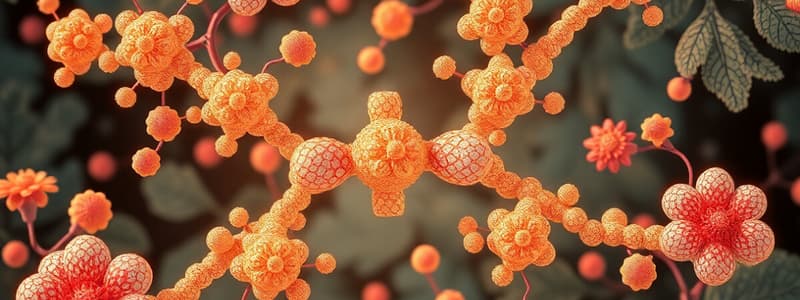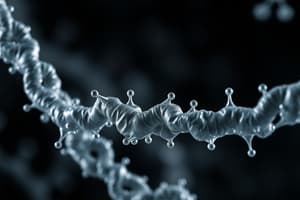Podcast
Questions and Answers
What is the primary function of carbohydrates in living organisms?
What is the primary function of carbohydrates in living organisms?
- Structural support
- Catalyzing reactions
- Providing insulation
- Energy storage (correct)
Which of the following is NOT a type of biomolecule?
Which of the following is NOT a type of biomolecule?
- Carbohydrates
- Proteins
- Nucleic acids
- Vitamins (correct)
What ratio of atoms do carbohydrates typically have?
What ratio of atoms do carbohydrates typically have?
- 1:2:1 (correct)
- 1:1:1
- 1:2:3
- 2:1:2
Which biomolecule is primarily involved in the structural component of cell membranes?
Which biomolecule is primarily involved in the structural component of cell membranes?
Which of the following statements about proteins is true?
Which of the following statements about proteins is true?
What is the primary function of nucleic acids?
What is the primary function of nucleic acids?
Which statement accurately describes lipids?
Which statement accurately describes lipids?
What differentiates the structure of DNA from RNA?
What differentiates the structure of DNA from RNA?
Flashcards
What are biomolecules?
What are biomolecules?
Organic compounds essential to all living things, involved in various biological processes like energy storage, structure formation, and catalysis. Composed mainly of carbon, hydrogen, oxygen, nitrogen, phosphorus, and sulfur.
What are the four main types of biomolecules?
What are the four main types of biomolecules?
The four major types of biomolecules are carbohydrates, lipids, proteins, and nucleic acids.
What are carbohydrates?
What are carbohydrates?
Organic compounds composed of carbon, hydrogen, and oxygen atoms in a 1:2:1 ratio. Classified into monosaccharides (simple sugars), disaccharides (two monosaccharides joined), and polysaccharides (many monosaccharides joined).
What are lipids?
What are lipids?
Signup and view all the flashcards
What are proteins?
What are proteins?
Signup and view all the flashcards
What are nucleic acids?
What are nucleic acids?
Signup and view all the flashcards
Describe the structure of DNA.
Describe the structure of DNA.
Signup and view all the flashcards
Describe the structure of RNA.
Describe the structure of RNA.
Signup and view all the flashcards
Study Notes
Introduction to Biomolecules
- Biomolecules are organic compounds essential to all living organisms
- They are involved in various biological processes, such as energy storage, structure formation, and catalysis
- Biomolecules are mainly composed of carbon, hydrogen, oxygen, nitrogen, phosphorus, and sulfur.
Types of Biomolecules
- Four major types of biomolecules: carbohydrates, lipids, proteins, and nucleic acids.
Carbohydrates
- Composed of carbon, hydrogen, and oxygen atoms in a 1:2:1 ratio
- Classified into monosaccharides (simple sugars), disaccharides (two monosaccharides joined), and polysaccharides (many monosaccharides joined)
- Functions:
- Primary source of energy for cells
- Structural components of plant cell walls (cellulose) and exoskeletons of some animals
- Involved in cell recognition and signaling
- Examples: Glucose, fructose, sucrose, starch, glycogen, cellulose
Lipids
- Diverse group of hydrophobic (water-repelling) molecules
- Primarily composed of carbon and hydrogen atoms
- Functions:
- Energy storage
- Insulation
- Structural components of cell membranes (phospholipids)
- Signaling molecules (hormones)
- Examples: Fatty acids, triglycerides, phospholipids, steroids (e.g., cholesterol)
Proteins
- Polymers of amino acids linked by peptide bonds
- 20 different amino acids exist, each with a unique side chain
- Structure: Primary, secondary, tertiary, and quaternary structure
- Functions:
- Structural support (collagen)
- Catalysts (enzymes)
- Transport (hemoglobin)
- Defense (antibodies)
- Regulation (hormones)
- Movement (actin and myosin)
Nucleic Acids
- Polymers of nucleotides
- Two main types: DNA (deoxyribonucleic acid) and RNA (ribonucleic acid)
- DNA: Stores genetic information
- RNA: Involved in protein synthesis
- Structure: DNA is a double helix; RNA is single-stranded
- Components: Nitrogenous bases (adenine, guanine, cytosine, thymine in DNA; uracil in RNA), sugar (deoxyribose in DNA; ribose in RNA), and phosphate groups
Studying That Suits You
Use AI to generate personalized quizzes and flashcards to suit your learning preferences.



